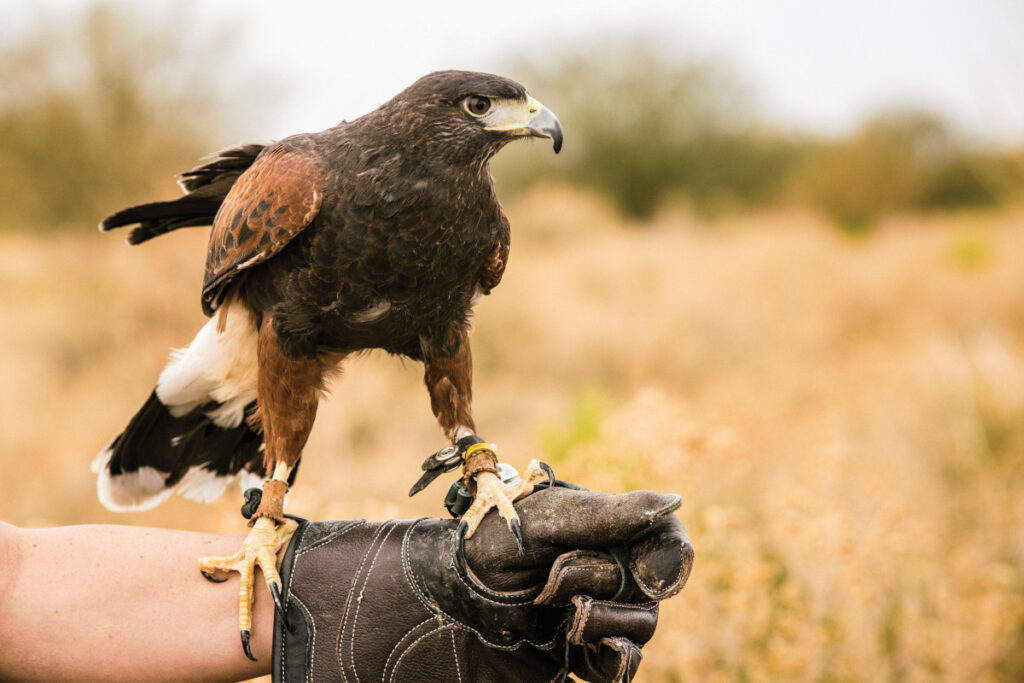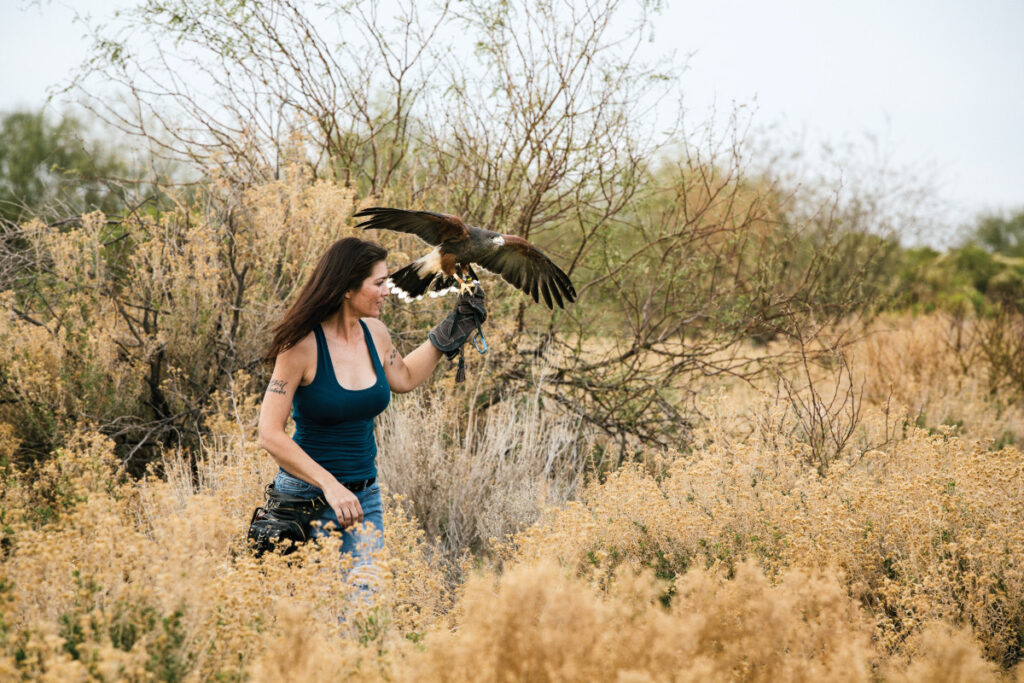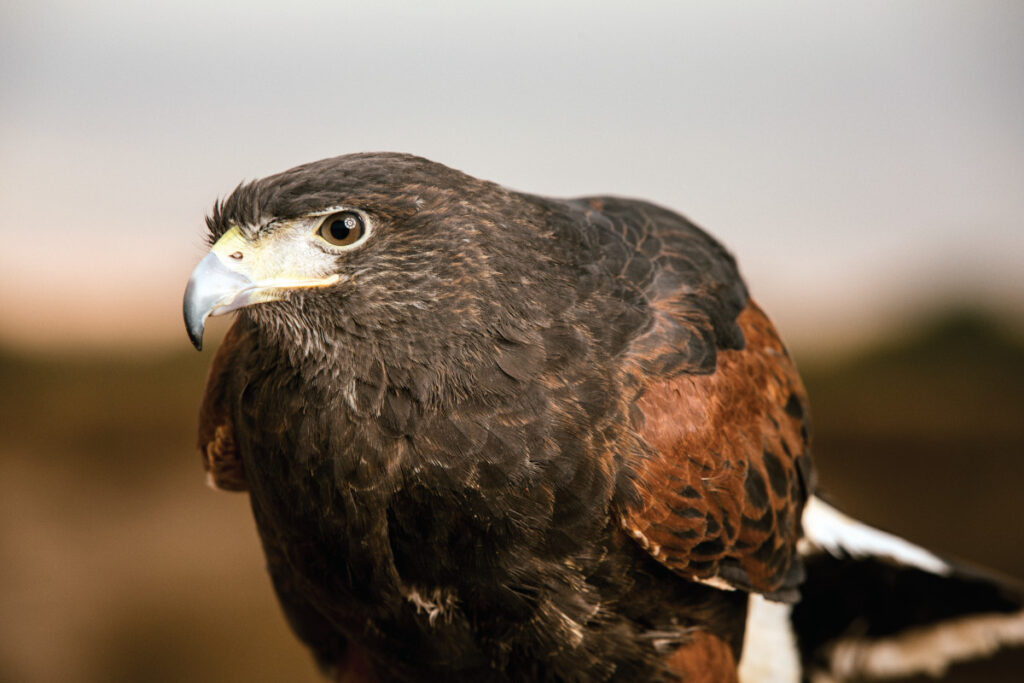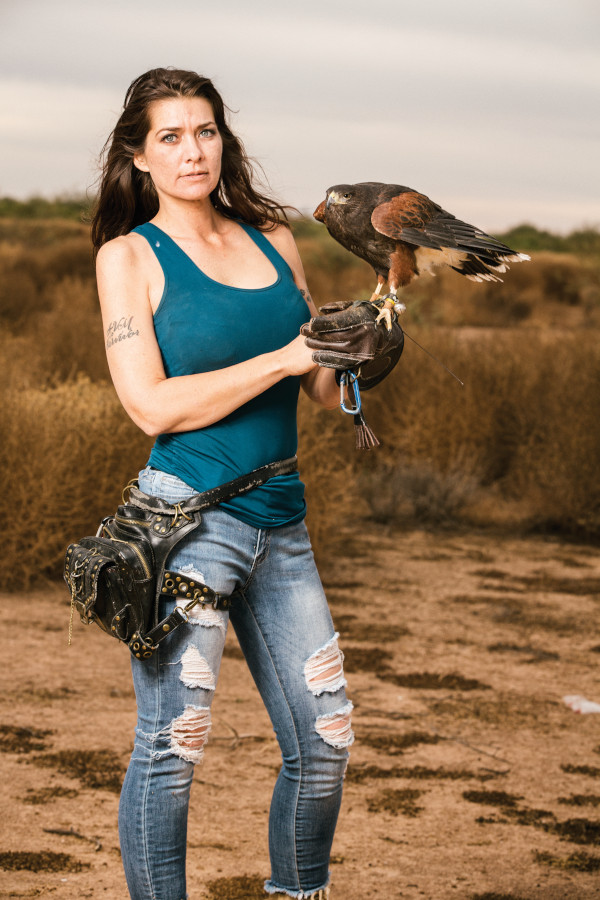At CarnivoreWeb.com, we independently review products and outfitters. However, we may earn a commission when you purchase products through links on our site. Read our affiliate policy. Read about how we test products.
Unlock the secrets of Falconry! Dating back at least a thousand years, this ancient form of hunting is as badass as it is effective.
Colloquially known to some as the sport of kings, falconry is a sport that can be traced easily back to the Middle Ages, if not further. The current public perception of this ancient pastime is riddled with myriad misconceptions, and given the relatively small number of knowledgeable practitioners, it’s easy to understand why.
The bottom line is that falconry is about working as a team to hunt with a bird of prey. The falconer provides the proper husbandry for the bird and works in the field to help the bird pursue small game. The wellbeing of the bird comes before all else in the sport.
For the first two years as a falconer, you must have an experienced falconer willing to mentor you. Although a lot can be taught within two years, the learning never truly stops, and you’re encouraged to continually seek information. A large part of that is based on facilitating new experiences with different birds, filling up your bookshelves with reliable reading material, and staying connected with the falconry community.
Some of the most common misconceptions tend to be associated with the bird’s relationship/bond with the falconer, the treatment the animal receives, and how the hunt is played out between the bird and the falconer.
THE PET HAWK
It’s not uncommon to be approached by someone while you’re out hunting with your bird. People have a lot of questions and are understandably curious. But one that almost always comes up usually goes something like, “So … that’s your pet?” While I look stupidly at my hawk, who’s perched on a tree branch waiting for me to flush a rabbit out of a bush, I do my best to convey the reality of what’s going on and how a bird of prey isn’t “pet” material. Don’t get me wrong; a chance to educate someone on falconry always puts a smile on my face.

Unfortunately, people don’t always hear the information the way they want to hear it. Also, my time in the field is devoted to my bird. A lot of people want to hear warm and fuzzy stories about befriending birds of prey, so they tend to keep steering the conversation in this direction. This is what usually leads to the stupid look on my face — frustration that sometimes people aren’t so much seeking education as validation of a story they’ve already told themselves.
While the idea of my hawk sitting next to me on the couch during Game of Thrones waiting for me to drop a potato chip comes to mind, that’s not how it works.
Surprisingly, most falconers don’t get into falconry to carry a bird of prey on their arm while basking in the glory of copious amounts of attention. We do it for the unique privilege of working as a team with these beautiful carnivores. These birds are designed to hunt and the more opportunity they have to practice that, the higher their success rate on game.
With all the time and energy we put into our birds/hunting buddies, sometimes the word pet feels like a gross understatement. But more importantly, we don’t want to give the general public the wrong idea about falconry. And just because we don’t refer to them as our pets doesn’t mean their needs go unmet.
The wellbeing of the bird is a priority because, first off, that’s what they’re entitled to. Properly tending to its needs will also contribute to the bird’s ability to provide for itself. We’re just the backup, the helping hand, a safe place to rest their head at night, and sometimes they do seem to appreciate our companionship.

My current bird is a Harris’s hawk. This is the only bird of prey that lives and hunts in a family group of other Harris’s hawks. Being a more social bird, I make sure he has good company for a good portion of the day. Other birds are perfectly fine being left alone after a hunt. You won’t hear stories about how someone’s bird of prey saved the neighborhood kid from drowning or how they like to cuddle after you come home from surgery.
When I walk past my hawk and drop a potato chip, his first reaction is to grab it now and sort out the details later. Think less Lassie and more Jurassic Park with slightly smaller raptors and, if you want to see things get really interesting, walk by them with a bowl of spaghetti.
THE HUNT
“So you release the hawk and he fetches food for you?” Not exactly.
It’s 4:30 p.m. I briefly check familiar hunting grounds for signs of life, from potential prey to any predator that may threaten the life of my hawk. I whisper, “Let’s play” as I unveil my ward from his hood. He scans the area, takes off from my glove, and perches in a high tree. His viewpoint is ideal for spotting any movement across the landscape. My own movement is meant to trigger prey, hopefully in his direction.
Enough hunts together have taught us how to read one another’s body language. My hunting partner has his eyes fixated on something, his head lowered. I’m able to deduce a general idea of what direction I need to start moving in. We’d be lucky to get a kill at the first opportunity. Sometimes we’re in the field for 10 minutes and done, sometimes an hour or more.
Swiftly plowing through brush, I manage to flush out a cottontail rabbit. Luckily, it was headed in the right direction. My bird takes flight. The hardest parts in these next few moments are keeping up the pace and avoiding face-planting into one of Arizona’s unforgiving, thorn-filled bushes while keeping track of the tenacious beast in the sky. Each hunt is different. Not every flight takes the same pattern and not every unlucky prey that ends up under my bird takes the form of a rabbit.

Gaining speed, the predator pivots downward, tucks his wings in and cuts through the air like an impervious arrow. I stop and stare, entranced. I’ve seen this so many times, but the hawk’s deadly grace never ceases to amaze. My bird is out of sight, which means it’s time to kick it into high gear while listening for the cries of a rabbit bound in his talons. A panicky shrill leads me to nature’s crime scene. Talons behind the neck of a cottontail, hawk intensely focused with an unforgiving grip. I carefully slide in and use my hands to extinguish the life of the rabbit, a swift end to suffering, and patiently wait for my partner to finish his victory meal.
With bloodstained hands and a full carnivore on my tattered leather glove, I look over my bird to make sure he sustained no injuries. Then myself. New tears in old jeans, scratched up arms and hands, dead leaves decorating my dirt-dusted shirt, and a half grin. The scene more closely resembles a low-grade horror movie than the Norman Rockwell prints of men and their gun dogs. It’s likely a little unsettling for the unprepared who happen to cross my path. But this is the falconer’s reality — dirty, bloody work that doesn’t look anything like fetch with Fido.
ACQUIRING A BIRD OF PREY
Another question that’s frequently asked is how I acquire my birds. Most folks assume that these birds are all from a rescue. The most common options are to buy from a licensed falconry breeder or trap/take a wild bird within its first year of life.
Birds of prey are federally protected, and each state has their own additional set of laws. You can’t possess, trap, or even keep the feathers of a bird of prey without the proper licensing. Even with a license, there are laws falconers must abide by.
Trapping a first-year bird is a topic that sometimes puts falconers under scrutiny. What’s often misunderstood is the role falconers play in the preservation of raptors.
The first year of life for a raptor is the hardest, with an estimated 80-percent mortality rate. Starvation, predation, pesticides, electrocution, and disease are some of the largest contributing factors impacting loss.
Taking and manning/acclimating a wild bird is done humanely and with as little stress on the animal as possible. Food-driven and intelligent, it doesn’t take long for these birds to figure out who’s supplying fresh chow. After a short period, if manning is done correctly the bird is ready to be set free. This is when the falconer finds out if the time invested into establishing a bond will be reciprocated by the bird returning to the glove. Sometimes they take flight and decide they’re better off on their own.

If the bird responds as planned, you pick your heart up off the ground and start hunting. It’s vitally important to give that bird as much opportunity to hunt as often as possible. The instinct to survive is inborn, but the ability to hunt successfully comes from trial and error.
In the wild, if the bird doesn’t eat it goes hungry. If it continually misses a meal it weakens, leaving it vulnerable to the inevitable. If it sustains an injury that hinders its ability to hunt, it won’t survive.
Under the care of the falconer, the bird will never have to starve because of its inexperience as a hunter.
In addition to having a safe place to sleep and the option of veterinarian care at the bird’s disposal, under these conditions the bird’s ability to sharpen its survival skills have substantially increased.
When the hunting season ends, the option to release the bird back into the wild is usually taken and done often. Though not immune to the harsh aspects that come with living wild, the winged beast is much more prepared to survive after its partnership with a falconer.
There are so many unseen facets to the sport of falconry. The time invested in searching for land to hunt on, caring for the bird, and time in the field are instrumental elements that consume considerable amounts of time.

With this kind of dedication, sacrifices and adjustments in one’s daily routines or other activities are made accordingly. Understanding the behavior of raptors, knowing and staying current with federal regulations as well as your state’s falconry regulations, and learning symptoms of illness with birds is important, especially since they instinctively hide ailments to ensure their survival.
Being subject to ridicule on occasion is expected and usually handled tactfully. It’s another opportunity to correct any misconceptions or an opportunity to test your verbal filter. If you’re prone to a weak stomach, have a fear of sharp flying objects and a propensity to avoid getting your hands dirty — you’re welcome to enjoy the show; just don’t ask us where to apply. For those who practice, falconry is more than a hobby, leisure activity, or pastime. It’s a way of life.
READ MORE:
- Elk Hunting In Montana’s Bob Marshall Wilderness
- Best Pump-Action Shotguns For Hunting [Field Tested]
- Roasted Rooster: From Field To Fire
Why You Can Trust CARNIVORE
Since its launch, CarnivoreWeb.com has been a trusted authority on hunting, fishing and wild food, delivering expert insight for outdoorsmen who live the field-to-table lifestyle. More than a hunting and fishing site, CarnivoreWeb.com covers the full spectrum of the modern outdoors—from rifles, bows, and fishing gear to cooking, conservation and adventure.
Our contributors are drawn from across the hunting and angling world, including seasoned guides, lifelong hunters, competitive shooters and outdoor writers with decades of field experience. Every review, article and feature is built on firsthand testing, deep research, and an unwavering commitment to accuracy.
Commitment to Journalistic Principles
At CarnivoreWeb.com, upholding journalistic integrity is our top priority. We follow strict editorial standards to ensure all content is accurate, transparent, and unbiased. Our editors and writers operate independently, free from outside influence, advertisers or stakeholders. We adhere to established journalistic codes of ethics, holding ourselves accountable for the information we publish, correcting errors when they occur and disclosing any potential conflicts of interest.
This commitment ensures that our readers can trust CarnivoreWeb.com to provide reliable, honest coverage that helps them make informed decisions—whether selecting gear, honing outdoor skills or preparing wild game.
Find out more about our Editorial Standards and Evaluation Process


